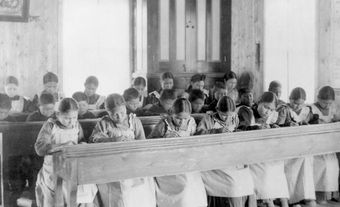Criminal Code, Section 98
Section 98 was an offence in the CRIMINAL CODE of Canada from 1919 to 1936. The section was drafted in 1919 in response to the general labour unrest in the country, which culminated in the WINNIPEG GENERAL STRIKE. The strike's leaders were charged with various sedition charges, but there were concerns in the federal government about the extent of labour unrest following the First World War. The government felt there was no legal precedent in law secure enough to allow for the prosecution of radical groups that challenged governmental authority. The basis for the wording of Section 98 came from the WAR MEASURES ACT, which the government enacted during the First World War; Section 98 was modelled specifically after Order-in-Council 2384.
Section 98 was a contentious matter for politicians, particularly those who came from labour organizations. Labour groups across the country vigorously protested the section and demanded its repeal, fearing it would be used to target labour groups engaged in legitimate forms of dissent such as strikes and rallies, and against labour groups such as unions. MACKENZIE KING's Liberal government attempted to have the section repealed and even passed bills through the House of Commons only to have the bills fail in the Senate. J.S. WOODSWORTH repeatedly sought its repeal in the 1920s and 1930s as did the Liberal Party of Canada and the Communist Party of Canada (CPC).
Draconian Elements of Section 98
Parts of the section violated Canadians' basic liberties. It was principally concerned with prosecuting those who were members of an "unlawful organization." The section stated that "Any person who acts or professes to act as an officer of any such unlawful association, and who shall sell, speak, write or publish anything as the representative or professed representative of any such unlawful association, or become and continues to be a member thereof...shall be guilty of an offense..." The penalties under Section 98 were severe - the maximum penalty for violating it was 20 years' imprisonment.
One of the main concerns with the section was its vague definitions. An "unlawful organization" was defined as one that advocated the "use of force" in promoting economic or governmental change, but "force" was left open to interpretation. The section permitted government seizure of the property of a "suspected" unlawful organization and made it illegal for any building owner to lease a building to an unlawful organization under threat of a maximum prison sentence of five years. Most building owners in the 1930s were wary of leasing their buildings to any labour group. The government could also prosecute members of an unlawful organization. Merely attending the meeting of an unlawful organization was enough for someone to be considered a member and the onus for proving one's innocence fell on the accused.
Convictions Under Section 98
Despite the draconian elements of the Code, few individuals were ever charged and convicted under it. The first ever conviction to be upheld occurred in the 1930s during the "red scare" of the GREAT DEPRESSION. In the case of Rex v Buck et al in November 1931, eight members of the CPC, including much of its leadership, were convicted under the Code. Most received a five-year prison term. The CPC was found to be an unlawful organization during the trial. With the party firmly established as unlawful, and as any member of the party was now considered to be breaking the law, federal authorities sought to deport members of the party (many of whom were foreign-born and had not yet received citizenship). Hundreds of party members were deported, some to countries where they could potentially face execution or torture because of their communist beliefs.
Section 98 was rarely invoked after the 1931 trial. Notable prosecutions include Arthur EVANS for his role in the Princeton mining strike in BC in 1932. The leaders of the ON TO OTTAWA TREK, which also included Arthur Evans, were charged under Section 98 in July 1935 but the charges were dropped early in 1936. After the fall of R.B. BENNETT's Conservative government in 1935, the new Liberal government of Mackenzie King repealed the very unpopular Section 98 with Royal Assent given in June 1936. Although Section 98 was officially removed from the Criminal Code, the King government did strengthen the sedition section of the Code, Section 133, to include many elements of Section 98; however the "unlawful organization" classification was removed and the penalty for violating the section was also reduced.

 Share on Facebook
Share on Facebook Share on X
Share on X Share by Email
Share by Email Share on Google Classroom
Share on Google Classroom


